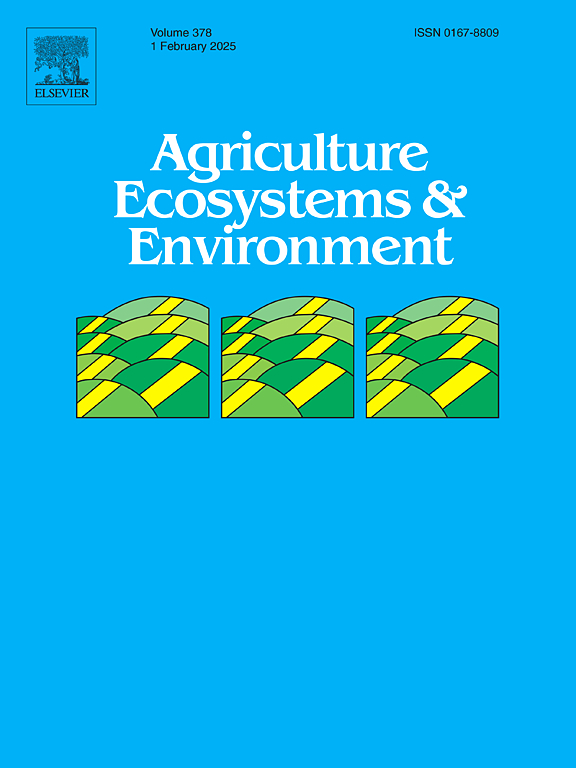在全绿肥掺入的免耕条件下,通过增加优势菌丰度和减少细菌多样性来提高土壤质量和作物产量
IF 6
1区 农林科学
Q1 AGRICULTURE, MULTIDISCIPLINARY
引用次数: 0
摘要
土壤微生物群落的丰度和多样性是评估土壤健康状况的重要指标。然而,绿肥掺入影响土壤质量和作物产量的微生物机制仍不清楚。我们在河西走廊进行了实地研究,探讨了不同绿肥管理策略下微生物群落与土壤质量之间的相关性。在普通薇菜的花期,实施了四种管理策略:全绿肥掺入的耕作(TG)、全绿肥覆盖的免耕(NTG)、仅根部掺入的耕作(T)和去除地上部绿肥的免耕(NT),并以不施绿肥的常规耕作作为对照(CT)。掺入全部绿肥可明显改善土壤质量指数(SQI)和玉米产量,NTG 的效果比 TG 更明显。土壤有机质(SOM)和全氮(TN)是影响 SQI 的主要因素。在 NTG 中,主要菌门和菌属的相对丰度增加,尤其是放线菌和节杆菌,这与土壤特性相关。此外,施用 NTG 和 TG 导致细菌α多样性减少。回归分析表明,细菌α多样性与 SOM、TN 和矿物氮含量呈负相关。细菌群落的多样性对 SQI 有负面影响。导致细菌多样性减少的主要因素是土壤 pH 值、硝酸盐氮(NO3--N)和铵态氮(NH4+-N)。总之,NTG 通过优化土壤特性减少了细菌多样性,提高了优势细菌的丰度,从而提高了土壤质量。本文章由计算机程序翻译,如有差异,请以英文原文为准。
Enhancing soil quality and crop yield by increasing dominant bacterial abundance and reducing bacterial diversity under no-tillage with total green manure incorporation
The abundance and diversity of soil microbial communities are important indicators for evaluating soil health. However, the microbial mechanism by which green manure incorporation affects soil quality and crop yield remains unclear. Field research was conducted in the Hexi Corridor to investigate the correlations between microbial communities and soil quality across various green manure management strategies. During the flowering period of common vetch, four management strategies were implemented: tillage with total green manure incorporation (TG), no-tillage with mulching using total green manure (NTG), tillage with only root incorporation (T), and no-tillage with the removal of aboveground green manure (NT), with conventional tillage without green manure as the control (CT). Total green manure incorporation significantly improved the soil quality index (SQI) and maize yield, with NTG demonstrating a more pronounced effect than TG. Soil organic matter (SOM) and total nitrogen (TN) were the primary contributors to the SQI. The relative abundances of the predominant phyla and genera increased in NTG, particularly Actinobacteria and Arthrobacter, which correlated with soil characteristics. Furthermore, the application of NTG and TG resulted in a reduction in bacterial alpha diversity. Regression analysis revealed negative correlations between bacterial alpha diversity and the SOM, TN, and mineral N contents. The diversity of the bacterial community negatively affected SQI. The primary factors contributing to the decrease in bacterial diversity were soil pH, nitrate nitrogen (NO3−-N), and ammonium-nitrogen (NH4+-N). In summary, NTG reduced bacterial diversity, and improved the abundance of dominant bacteria by optimizing soil characteristics, thereby increasing soil quality.
求助全文
通过发布文献求助,成功后即可免费获取论文全文。
去求助
来源期刊

Agriculture, Ecosystems & Environment
环境科学-环境科学
CiteScore
11.70
自引率
9.10%
发文量
392
审稿时长
26 days
期刊介绍:
Agriculture, Ecosystems and Environment publishes scientific articles dealing with the interface between agroecosystems and the natural environment, specifically how agriculture influences the environment and how changes in that environment impact agroecosystems. Preference is given to papers from experimental and observational research at the field, system or landscape level, from studies that enhance our understanding of processes using data-based biophysical modelling, and papers that bridge scientific disciplines and integrate knowledge. All papers should be placed in an international or wide comparative context.
 求助内容:
求助内容: 应助结果提醒方式:
应助结果提醒方式:


